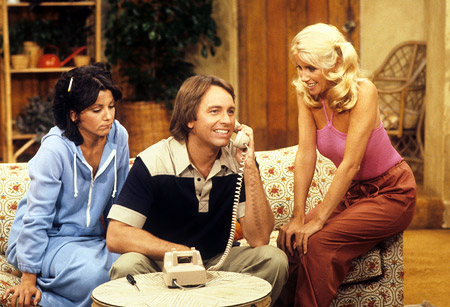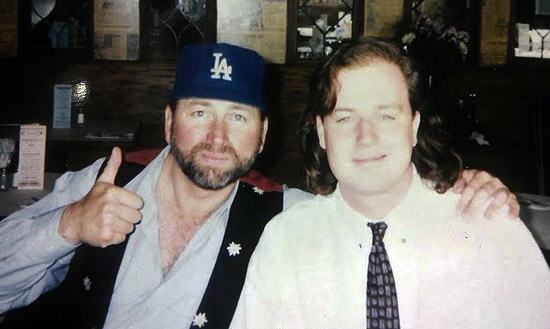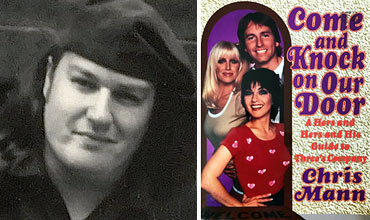For the occasion The Bits features a Q&A on the popular series, and who better to turn to than Three’s Company authority and author Chris Mann.
Chris Mann is the author of Come and Knock on Our Door: A Hers and Hers and His Guide to Three’s Company (St. Martin’s, 1998 – you can order a copy from Amazon by clicking here or on the book cover image below). The writer, consultant and digital media producer also served as consulting producer on NBC’s hit, franchise-launching 2003 movie-of-the-week, Behind the Camera: The Unauthorized Story of Three’s Company. As a magazine art director, he has produced and directed cover, editorial and video shoots with actors such as Eva Longoria, Gilles Marini, Cheryl Ladd and Joyce DeWitt and bestselling authors, including thought leader Marianne Williamson. During his 20-plus years as a freelance journalist, he has written for TV Guide, the Los Angeles Times, emmy magazine and other entertainment titles while interviewing actors, authors, doctors and Olympic and professional athletes for numerous health and fitness magazine cover stories focusing on body, mind and spirit. He is presently working on his next two books: a biography on Three’s Company star John Ritter and a behind-the-scenes tell-all about the iconic CBS game show The Price is Right.
Michael Coate (The Digital Bits): In what way is Three’s Company worthy of celebration on its 40th anniversary?
Chris Mann: It’s worthy because it’s a timeless classic that changed the landscape of the television sitcom, even if critics still refuse to sing its praises as a contemporary French farce that helped redefine the domestic situation comedy. The show’s timelessness is due in no small part to the ongoing appeal of the late, great John Ritter — whose talents also live on in his children, two of whom, sons Jason and Tyler, have themselves starred in sitcoms.
Three’s Company continues to air on Antenna TV and Logo. I was present last month at the taping of a cast retrospective that aired during a recent Antenna TV 40th anniversary celebration. Richard Kline choked up when talking about John, and Jenilee Harrison lit up when lovingly recalling John as a kind coworker and a family man. Even though Jenilee was on the show only for two seasons, she remains part of the Three’s Company family. She came up to me with the sweetest words about my book — and how she brought her copy for the rest of the cast to sign. In that moment, I was reminded why this show touched people’s hearts: because it was about a group of people who genuinely cared for each other. That alone makes it a prime candidate for celebration.

Coate: Can you describe seeing Three’s Company for the first time?
Mann: I grew up in the Bible Belt in rural Oklahoma. Fortunately, my mom had a more liberal take on the difference between “family fare” and “adult” shows, so I was allowed to watch Three’s Company but not, for instance, Soap. Our television set always seemed to be tuned to ABC, as I recall watching everything from Laverne & Shirley and Welcome Back, Kotter to Charlie’s Angels and S.W.A.T. as early as late 1975, when I was 3. So I definitely remember watching Three’s Company during its first season in spring 1977. The sexual innuendo went over my head. Instead, I was fascinated by John Ritter’s physical comedy. The scene in which Jack Tripper, when startled, leaps like a frog into the bathroom in the sixth episode, It’s Only Money, made me howl with laughter.
That episode premiered on my fifth birthday (April 21, 1977). My mom and my sister were laughing, too, but my dad despised what he angrily called “The Idiot Box” — and at times he threatened to “throw it through the window.” I knew he wasn’t joking. Emulating John Ritter-as-Jack Tripper’s easygoing and anything-for-a-laugh qualities nonetheless seemed to kind of neutralize my dad at times, and employing quick quips and Tripper-esque pratfalls helped me tremendously at school, too. Needless to say, Three’s Company soon became the feel-good gift that — even during my years as an overwhelmed college newspaper reporter/editor and honors student at the University of Tulsa — kept on giving. In the age of the Internet, many fans of the show have shared with me that they also watched and loved the show, in many cases from a young age, to escape life’s dramas — if only a momentarily, to sort of release tension with laughter. It’s amazing how such a silly sitcom can help refuel the spirit by helping us appreciate life’s absurdities. Three’s Company constantly reminded that such a shift in perspective can help us tackle the not-so-funny stuff in life.

Coate: What was the objective with your Three’s Company book?
Mann: My intention with Come and Knock on Our Door always was to celebrate the show, give proper recognition to the farcical stylings and often underappreciated talents that made it a hit and — once and for all, and above all — uncover and tell the true human story behind a once-controversial if critically misunderstood sitcom and its stars’ successes, struggles, breakthroughs, setbacks, harmonies, conflicts, losses and eventual triumphs. In addition to being groundbreaking in large part due to its premise (A young, engaging male lead pretends to be gay so his suspicious landlords let him live with two young, engaging women?! In primetime?! In Middle-American living rooms?! How will we protect the children?!), Three’s Company became a blueprint of sorts for how a hit series survives “moral” outrage and other negative publicity, tumultuous backstage and public feuds, show-changing cast exits and the bitter, lingering breakups of its original stars — all while continuing to emanate the love and generate the laughter that attracted millions of viewers in the first place.
As a journalist, as an enthusiast and just as who I am as a human being, it was imperative for me to get to the heart of the matter with truth, integrity, love, empathy and, where appropriate, the quality I’ve always found the most disarming and healing: humor. I realized early on that achieving my objective meant going well beyond the sort of “extended episode guide” approach I’d seen in other TV books. Instead, it required essentially penning four biographies in one: The no-holds-barred life story of Three’s Company and, at least insofar as they are interconnected and pertain to this life-changing experience, the transformational stories of its three original stars. At its core and beyond its pratfalls, double entendres and misunderstandings, this sitcom was about chemistry, relationships and, ultimately, understanding — and so, too, was my book. (And folks use to say Three’s Company wasn’t deep! HA!) Did I do justice to my mission of saluting, illuminating and attempting to bring back together a former TV family? Readers’ heartfelt online reviews and my battle scars seem to suggest so!

The Three’s Company story continues, even 13 and a half years after the untimely passing of its creative and emotional center, the brilliant John Ritter. So I’m looking at an updated version of Come and Knock on Our Door for 2018 — the 15th anniversary of John’s passing, the 20th anniversary of St. Martin’s Press’s publication of my book and the 40th anniversary of the year the show first shot to number one in the ratings. John supported me and my book from the get-go — he even spoke kindly and generously about the book and its grateful author during various national television appearances — so I’d love to release a special edition that pays tribute to him and his legacy. This “reboot” might serve as a prologue of sorts to my long-in-the-works book on this most remarkable and surprisingly multi-layered man. He certainly inspired a generation… or three.
Coate: In what way was Three’s Company significant within the situation comedy genre?
Mann: Three’s Company redefined the domestic television comedy to embrace mixed-singles cohabitation. It brought the notion of “friends as family” into our living rooms long before Friends and Will & Grace did. Jack Tripper and company were family. Even the landlords and Larry and Lana were in and out of the roommates’ two-bedroom apartment more than any sex-starved building manager or wacky neighbor should be. But the trio’s cozy dwelling was a safe place, a home, for all. Intercourse was not required for male-female intimacy or, for that matter, the propagation of family.
Of course, Three’s Company did push the envelope with its permissiveness and suggestiveness, thus paving the way in the genre for more sexual openness. But more importantly perhaps, I think this sitcom helped open the door to portraying a wider spectrum of how men and women can and do relate to each other beyond sexuality and the once-strict definition of “gender roles.” (I would even argue that Jack Tripper, in his soft-spokenness and “big-brotherliness” with his female roommates, helped redefine what it means to be “masculine.” And even in outlandish ways — for instance, his hissing at the homophobic Mr. Roper and his comfort in dressing in drag, if just for a laugh — I think John showed audiences that Jack was comfortable with his masculinity enough that he was hip to being in touch with qualities that our society has defined as more “female” or “feminine.” This farcical handling of sensitive matters succeeded without being offensive — at least in the eyes of most Americans, I would argue — thanks to the character and talents of John Ritter. I think that for many people to understand or embrace that which is — and those who are — different, humor must be used to break down the walls of division. John definitely understood this.)
In these ways, Three’s Company helped liberate the TV sitcom. Within a decade of its premiere, mixed-singles domestic and workplace comedies were being pitched with loglines of “Three’s Company meets (insert qualifier here).” Ten years after Jack and company became part of the TV landscape, Married… with Children premiered — in essence, the Bundys are the Ropers with a couple of the Three’s Company tenants as their kids. And 20 years after Three’s Company hit the scene, the genre saw an openly gay lead character/actor in Ellen. I always viewed Ellen DeGeneres’ character, the klutzy and befuddled Ellen Morgan, as a sort of female Jack Tripper — who himself was kind of a male Lucy Ricardo. On this note, I cannot stress enough how John Ritter elevated physical comedy to sitcom art, just as Lucille Ball did with her iconic series. (Lucy agreed!) His skills as a farceur will forever make Three’s Company relevant as the sitcom that brought the classic French farce to American television — two decades before Frasier did (in a more “sophisticated” manner) with episodes such The Ski Lodge.

Coate: Is there an ideal episode (if not the pilot) to introduce to someone who has never seen the show?
Mann: Because Three’s Company evolved from basically a bedroom farce to what I call a “physical farce” — and at no time was anything “physical” ever happening in the bedroom on this show — I would recommend two introductory episodes, maybe in addition to the pilot: season 3’s The Bake-Off and season 6’s Urban Plowboy. The former features the original ensemble — including Norman Fell, Audra Lindley and, in what is among her best comedic work, a whole-pie-engulfing Suzanne Somers — in a double entendre-rife, slapstick-laden misunderstanding of dessert-throwing proportions. The latter showcases the final ensemble, including the ever-hilarious Don Knotts as Mr. Furley, in a piece that hilariously illustrates how Three’s Company was ultimately a showcase for John Ritter’s physical comedy, complemented masterfully by Joyce DeWitt as well as Priscilla Barnes, Jenilee Harrison and “crazy Larry” himself, Richard Kline.
Coate: Is it necessary to watch the episodes in their original production order?
Mann: Not at all. So long as you know the basic setup and who’s who in terms of the characters and their tenures (lest Ann Wedgeworth’s brief appearance as Lana confuse you), each episode pretty much stands on its own.
Coate: Which are the standout episodes?
Mann: Up in the Air (season 6) is arguably the best episode of the series. It is among the funniest episodes of any sitcom of all time. It’s my favorite, it’s generally a fan favorite and it was John Ritter’s favorite. It was the comedy performance of his lifetime, I think — all to the tune of a lengthy, quintessentially Ritter/Tripperesque dance. Insanely funny. Also: Jack’s Tattoo (season 8) and Eyewitness Blues (season 6) feature some of his best scenes with DeWitt and Knotts. (I actually fell off my bed laughing at Jack’s post-sedative, pre-tattoo-removal hospital scenes when Jack’s Tattoo first aired in 1984. Janet thinks Jack’s getting a vasectomy and Mr. Furley thinks he’s having a sex change — and then he thinks Jack had a baby. Oh, those zany misunderstandings!) Chrissy’s Hospitality (season 4) features some of the original trio’s most laugh-out-loud moments, Somers’ ultimate portrayal of Chrissy and Knotts’ most gut-busting facial contortions. Season 3’s The Love Diary showcases Lindley and Fell at their finest. Strangers in the Night (season 6) illustrates the comic chemistry between Ritter and Kline. The Case of the Missing Blonde (season 5) is a funny episode featuring the show’s “in-between” ensemble when Harrison was the accident-prone third roommate. And Two Flew Over the Cuckoo’s Nest (season 6), Breaking Up Is Hard to Do (season 7) and The Charming Stranger (season 8) showcase some of Ritter, DeWitt and Barnes’ funniest ensemble work.

Coate: The third lead and the supporting characters came and went over the course of the series. As such, which era of the series do you think was the best?
Mann: A tough question, in part because the show was essentially a bedroom farce with physical comedy mixed in during its first four seasons and then became a full-on physical comedy of errors in its final four years. (And — I say this somewhat lightheartedly — I don’t want to get in the middle of yet another Three’s Company argument!) As such, the original cast, with Somers, Fell and Lindley (and then Kline, Knotts and Wedgeworth), shined in the first format, and the final cast, with Barnes, Kline and Knotts (and initially Harrison), worked beautifully together in what one might call the revised format. Aside from illustrating what episodes are among my favorites, I think it’s wise to leave it at that.
Coate: What are your thoughts on the DVD season sets of the series?
Mann: I participated in the production of bonus materials that appeared in the releases of seasons 1-5. As a creative consultant, I penned liner notes, recorded audio commentary, wrote featurette intro material, advised on clip usage/content and interviewed cast and crew for the John Ritter remembrances. I think the first five seasons were well packaged, and I was proud to be a part of them. I’m sure the final three seasons are nicely done, too. Funnily enough, I do not own seasons 5-8 on DVD. I’m still old school when it comes to classic television — I prefer to catch a half-hour or hour while channel surfing. But it’s great to know that others have all of the uncut episodes handy, and I hope the “extras” are equally meaningful to them.

Coate: Three’s Company, like many shows of its vintage, was originated on standard-definition video and, as such, is sort of trapped in a lower-resolution format (unlike the future-proofing that originating on film can provide). How will the show remain viable now that the high-definition age is upon us?
Mann: Despite having what we would now consider a dated, lower-resolution appearance, I believe Three’s Company will remain viable and enjoyable for generations to come simply on the strength of its scripts and performances.
Coate: What is the legacy of Three’s Company?
Mann: Its legacy as sitcom is that it made people laugh at the absurdities of life — or at least the absurdities of life in apartment 201. Three’s Company pushed the envelope initially but will be remembered and embraced as a fun-loving romp — a domestic farce, if you will — that showcases some of television’s best physical comedy and ensemble magic, led by the medium’s master farceur, John Ritter.
Coate: Thank you, Chris, for participating and sharing your thoughts about Three’s Company on the occasion of its 40th anniversary.
---
- Michael Coate




